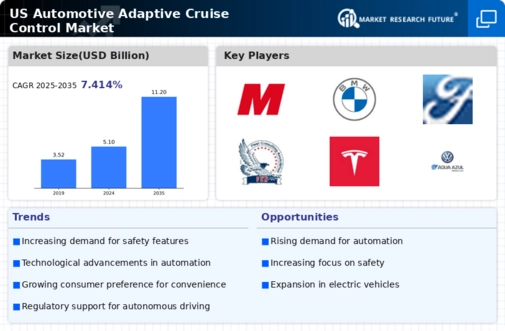Increased Focus on Fuel Efficiency
Fuel efficiency remains a pivotal concern for consumers and manufacturers alike, significantly impacting the automotive adaptive-cruise-control market. Adaptive cruise control systems contribute to improved fuel economy by optimizing vehicle speed and reducing unnecessary acceleration and braking. Studies indicate that vehicles equipped with adaptive cruise control can achieve fuel savings of up to 15%. As fuel prices fluctuate and environmental regulations tighten, the demand for technologies that enhance fuel efficiency is likely to rise. This trend suggests that manufacturers will increasingly incorporate adaptive cruise control features into their vehicles to appeal to eco-conscious consumers. Consequently, the automotive adaptive-cruise-control market is poised for growth as it aligns with the broader industry shift towards sustainability and efficiency.
Government Initiatives for Road Safety
Government initiatives aimed at improving road safety are playing a crucial role in shaping the automotive adaptive-cruise-control market. Various states have implemented regulations that encourage the adoption of advanced safety technologies, including adaptive cruise control. These initiatives are often part of broader strategies to reduce traffic accidents and fatalities. For instance, the National Highway Traffic Safety Administration (NHTSA) has been actively promoting the integration of advanced driver assistance systems in new vehicles. This regulatory support is expected to drive the automotive adaptive-cruise-control market as manufacturers comply with safety standards and consumers become more aware of the benefits of these technologies. The emphasis on road safety is likely to result in increased investments in adaptive cruise control systems.
Consumer Preference for Luxury Features
The automotive adaptive-cruise-control market is significantly influenced by the growing consumer preference for luxury and high-end features in vehicles. As consumers seek more sophisticated driving experiences, manufacturers are increasingly incorporating adaptive cruise control systems into their premium models. This trend is evident in the luxury vehicle segment, where adaptive cruise control is often considered a standard feature. Data shows that the luxury car market is projected to grow by 8% annually, further driving the demand for advanced features. Consequently, the automotive adaptive-cruise-control market is likely to expand as manufacturers respond to consumer expectations for enhanced comfort and convenience in their vehicles.
Rising Demand for Enhanced Driver Assistance
The automotive adaptive-cruise-control market is experiencing a notable surge in demand for advanced driver assistance systems (ADAS). As consumers increasingly prioritize safety and convenience, the integration of adaptive cruise control features becomes essential. According to recent data, the market for ADAS is projected to grow at a CAGR of approximately 10% through 2027. This growth is driven by the desire for improved driving experiences and reduced driver fatigue. Furthermore, the automotive adaptive-cruise-control market is likely to benefit from the increasing number of vehicles equipped with these systems, as manufacturers strive to meet consumer expectations for enhanced safety features. The trend towards automation in vehicles is expected to further bolster the adoption of adaptive cruise control technologies, making them a critical component of modern automotive design.
Technological Integration with Connectivity Features
The automotive adaptive-cruise-control market is being propelled by the integration of connectivity features within vehicles. As the automotive industry embraces the Internet of Things (IoT), adaptive cruise control systems are increasingly being designed to communicate with other vehicle systems and infrastructure. This connectivity allows for real-time data exchange, enhancing the functionality of adaptive cruise control. For instance, vehicles can adjust their speed based on traffic conditions or road signs, leading to safer and more efficient driving experiences. The market for connected vehicles is expected to reach $200 billion by 2026, indicating a robust growth trajectory. This trend suggests that the automotive adaptive-cruise-control market will continue to evolve, driven by advancements in connectivity and smart technologies.


















Leave a Comment